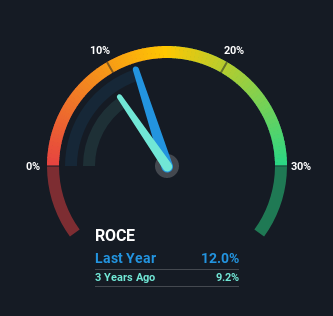- Brazil
- /
- Consumer Durables
- /
- BOVESPA:TRIS3
Trisul (BVMF:TRIS3) Shareholders Will Want The ROCE Trajectory To Continue
If we want to find a potential multi-bagger, often there are underlying trends that can provide clues. Ideally, a business will show two trends; firstly a growing return on capital employed (ROCE) and secondly, an increasing amount of capital employed. Put simply, these types of businesses are compounding machines, meaning they are continually reinvesting their earnings at ever-higher rates of return. With that in mind, we've noticed some promising trends at Trisul (BVMF:TRIS3) so let's look a bit deeper.
Understanding Return On Capital Employed (ROCE)
If you haven't worked with ROCE before, it measures the 'return' (pre-tax profit) a company generates from capital employed in its business. The formula for this calculation on Trisul is:
Return on Capital Employed = Earnings Before Interest and Tax (EBIT) ÷ (Total Assets - Current Liabilities)
0.12 = R$203m ÷ (R$2.2b - R$551m) (Based on the trailing twelve months to June 2021).
Thus, Trisul has an ROCE of 12%. On its own, that's a standard return, however it's much better than the 9.2% generated by the Consumer Durables industry.
See our latest analysis for Trisul

Above you can see how the current ROCE for Trisul compares to its prior returns on capital, but there's only so much you can tell from the past. If you'd like to see what analysts are forecasting going forward, you should check out our free report for Trisul.
How Are Returns Trending?
The trends we've noticed at Trisul are quite reassuring. Over the last five years, returns on capital employed have risen substantially to 12%. The company is effectively making more money per dollar of capital used, and it's worth noting that the amount of capital has increased too, by 160%. This can indicate that there's plenty of opportunities to invest capital internally and at ever higher rates, a combination that's common among multi-baggers.
The Bottom Line On Trisul's ROCE
To sum it up, Trisul has proven it can reinvest in the business and generate higher returns on that capital employed, which is terrific. And with the stock having performed exceptionally well over the last five years, these patterns are being accounted for by investors. Therefore, we think it would be worth your time to check if these trends are going to continue.
On a final note, we've found 2 warning signs for Trisul that we think you should be aware of.
While Trisul may not currently earn the highest returns, we've compiled a list of companies that currently earn more than 25% return on equity. Check out this free list here.
Valuation is complex, but we're here to simplify it.
Discover if Trisul might be undervalued or overvalued with our detailed analysis, featuring fair value estimates, potential risks, dividends, insider trades, and its financial condition.
Access Free AnalysisThis article by Simply Wall St is general in nature. We provide commentary based on historical data and analyst forecasts only using an unbiased methodology and our articles are not intended to be financial advice. It does not constitute a recommendation to buy or sell any stock, and does not take account of your objectives, or your financial situation. We aim to bring you long-term focused analysis driven by fundamental data. Note that our analysis may not factor in the latest price-sensitive company announcements or qualitative material. Simply Wall St has no position in any stocks mentioned.
Have feedback on this article? Concerned about the content? Get in touch with us directly. Alternatively, email editorial-team (at) simplywallst.com.
About BOVESPA:TRIS3
Trisul
Engages in the construction and development of real estate properties in Brazil.
Proven track record with adequate balance sheet and pays a dividend.
Market Insights
Community Narratives



